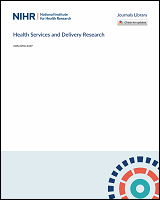NCBI Bookshelf. A service of the National Library of Medicine, National Institutes of Health.
Burton CR, Williams L, Bucknall T, et al. Theory and practical guidance for effective de-implementation of practices across health and care services: a realist synthesis. Southampton (UK): NIHR Journals Library; 2021 Feb. (Health Services and Delivery Research, No. 9.2.)

Theory and practical guidance for effective de-implementation of practices across health and care services: a realist synthesis.
Show details| Is the evidence good and relevant enough to be included in the review? | Yes – no – maybe |
|---|---|
| Q1: document ID/title | |
| Q2: authors/year published | |
| Q3: document type (e.g. research study/policy/local evidence/opinion) | |
| Q4: what is the study’s aim/purpose? | |
| Q5: what is the design/method used and was it appropriate for the aims/purpose of the study? | |
|
Q6: sample (type/size?) Factors relating to site, location, etc. | |
| Q7: what data collection method was used, if applicable? | |
| Q8: were the data collected in a way that addressed the research issue? | |
| Q9: how did the authors define the concept of de-implementation? | Did the authors provide an explicit definition or was it implied? (If yes, what was it? Source of definition?) |
| Q10: what is being de-implemented? | This is the focus of change relating to one or more context areas, such as clinical behaviour change or organisational policy |
| Q11: driving force | Which factors are motivating the de-implementation process (e.g., lack of evidence of effectiveness, financial constraints, or safety issues)? |
| Q12: nature of the action | What is the continuum of the de-implementation process (from complete termination to replacement with another innovation)? |
| Q13: degree of Intentionality | To what extent is the de-implementation process intentional and planned or passive and opportunistic? |
| Q14: consequences of the de-implementation process | Were the outcomes as expected or were there unintended consequences that occurred over time and for different stakeholders? |
| Q15: any other explanatory theory | Theories that have already been identified within the project or other relevant theories |
| Q16: level of de-implementation process | Micro – meso – macro levels |
| Q17: other |
ID, identification; Q, question.
- Extraction table template - Theory and practical guidance for effective de-imple...Extraction table template - Theory and practical guidance for effective de-implementation of practices across health and care services: a realist synthesis
Your browsing activity is empty.
Activity recording is turned off.
See more...